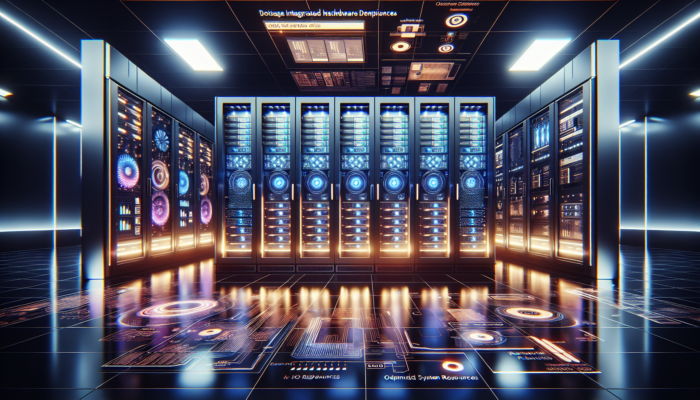System integration is an essential process in today’s digitally-driven landscape, where organisations aim to streamline operations, boost efficiency, and foster seamless collaboration. With the rapid pace of technological advancements, businesses are continually seeking methods to connect their diverse software systems to centralise data, automate processes, and enhance overall performance. In this article, we will explore the concept of system integration, its significance in the modern business environment, and how it empowers organisations to leverage the power of software for unified operations.
Understanding the Concept of System Integration
System integration involves the process of linking various software applications, platforms, databases, and systems to enable smooth data flow, communication, and interoperability. The primary goal is to create a cohesive environment in which different components of an organisation’s IT infrastructure can work together seamlessly. By bridging the gaps between disparate systems, system integration eliminates data silos, mitigates redundancy, and significantly enhances the capacity for making data-driven decisions.
This integration process ensures that each software application can communicate effectively and share data, allowing organisations to achieve a comprehensive view of their operations. It typically involves establishing connections between various systems, such as customer relationship management (CRM), enterprise resource planning (ERP), inventory management, and payroll systems, facilitating a seamless exchange of vital information.
The system integration process incorporates several key components, including data mapping, transformation, and synchronisation. Data mapping aligns the formats, structures, and semantics of data across different systems, enabling seamless data exchange. Transformation encompasses converting data from one format to another, ensuring compatibility between systems. Finally, synchronisation guarantees that data remains consistently updated and shared in real-time, enhancing operational efficiency.
The Importance of System Integration in Business

In the fiercely competitive business landscape of today, organisations rely heavily on a multitude of software solutions to manage various facets of their operations. These solutions often originate from different vendors, may utilise varying technologies, and serve distinct purposes. System integration plays a pivotal role in enabling these disparate systems to communicate, share, and exchange information efficiently. Let us explore the key reasons that highlight the critical significance of system integration for businesses:
1. Boosting Efficiency and Productivity through Integration
Integrating diverse software systems significantly enhances operational efficiency by automating processes, eliminating manual data entry, and reducing the risk of human error. This leads to improved efficiency and productivity, freeing up employees to concentrate on value-added tasks rather than repetitive administrative duties. For example, an integrated system can automate the transfer of information from customer relationship management (CRM) software to the enterprise resource planning (ERP) system, ensuring that sales orders are processed automatically, inventory levels are updated, and invoices are generated without requiring human intervention.
Beyond automation, system integration facilitates the smooth flow of information between systems, negating the need for manual data transfers and duplicate entries. This not only conserves time but also reduces operational costs associated with manual processes, allowing businesses to allocate their resources more efficiently.
<pWith system integration, organisations can streamline their workflows, ensuring that processes are executed consistently and efficiently. For instance, by linking the human resources (HR) system with the payroll system, employee data can be automatically synchronised, reducing administrative burdens and minimising the potential for errors.
2. Achieving Enhanced Data Accuracy and Consistency
System integration effectively eliminates data silos, allowing for real-time data exchange between different software applications. This ensures that all systems operate with accurate and up-to-date information, significantly reducing the risk of inconsistencies and errors. For instance, integrating the inventory management system with the sales system provides real-time visibility into stock levels, preventing situations of overselling and stockouts, which ultimately leads to improved customer satisfaction and informed decision-making.
Through system integration, organisations can establish a single source of truth, where data remains consistent and reliable across various systems. This capability enables businesses to make informed, data-driven decisions based on accurate and current information, allowing them to identify trends, recognise opportunities, and address potential issues proactively.
3. Streamlining Processes and Minimising Costs

Integration fosters the seamless exchange of information between systems, which eliminates the necessity for manual data transfers and repetitive data entry. This not only saves valuable time but also significantly reduces operational costs linked to manual processes. For example, connecting the human resources (HR) system with the payroll system guarantees that employee data is automatically synchronised, thereby minimising administrative overhead and potential errors.
By streamlining processes through system integration, businesses can lessen manual intervention, automate repetitive tasks, and eliminate bottlenecks. This results in heightened operational efficiency, reduced costs, and improved overall productivity. Consequently, organisations can focus their resources on strategic initiatives that drive growth and foster innovation.
4. Elevating the Customer Experience through Integration
System integration enables businesses to deliver a unified and cohesive experience to their customers. By integrating customer-facing systems such as CRM, e-commerce platforms, and support systems, organisations gain a comprehensive view of customer interactions, allowing them to tailor services accordingly. This integration facilitates personalised marketing campaigns, efficient order processing, and timely customer support, resulting in enhanced customer satisfaction and loyalty.
Through system integration, organisations can create a frictionless customer journey by ensuring that customer data is synchronised across various systems. This capability allows businesses to provide personalised experiences, anticipate customer needs, and deliver timely and relevant support. By fostering a deeper understanding of their customers, organisations can cultivate strong relationships and promote long-term loyalty.
5. Achieving Agility and Scalability in Business Operations
In today’s fast-paced business environment, organisations must adapt to changing requirements and scale operations accordingly. System integration offers the flexibility needed to add or replace software systems as necessary without disrupting the entire IT infrastructure. This agility empowers businesses to respond swiftly to market demands, integrate new technologies, and maintain a competitive edge.
With system integration, organisations can easily incorporate new applications, platforms, or technologies into their existing systems. This adaptability allows businesses to leverage emerging technologies such as cloud computing, artificial intelligence, and the Internet of Things to drive innovation and secure a competitive advantage. By remaining agile and scalable, organisations can future-proof their operations and effectively navigate evolving market trends.
Essential Considerations for Effective System Integration

While system integration presents numerous advantages, a strategic approach is vital to ensure successful implementation. Here are some critical considerations to keep in mind:
1. Establish Clear Objectives for Integration
Before initiating a system integration project, it is essential to define clear objectives and align them with the organisation’s overarching business goals. Identify specific pain points, determine the desired outcomes, and prioritise integration requirements accordingly. This clarity will guide your efforts and ensure that the integration project delivers tangible results.
By establishing clear objectives, organisations can channel their resources effectively towards the most pressing aspects of system integration. This focused approach helps ensure that the integration project aligns with the organisation’s strategic priorities and delivers meaningful outcomes.
2. Assess Various Integration Options Thoroughly
There are multiple integration approaches to consider, including point-to-point integration, middleware-based integration, and cloud-based integration platforms. Evaluate the available options based on factors such as scalability, security, user-friendliness, and requirements for future growth.
Take into account the specific needs of your organisation, the complexity of your IT infrastructure, and the scalability requirements for future evolution. Assess the advantages and disadvantages of each integration approach and select the one that best meets your organisation’s needs and long-term objectives.
3. Strategise for Data Mapping and Transformation
Data mapping and transformation are pivotal elements in system integration. It is crucial to ensure that data formats, structures, and semantics are aligned across multiple systems to facilitate seamless data exchange. Consider employing tools or platforms that offer robust data mapping capabilities to enhance this aspect.
Data mapping includes defining the relationships and transformations between data elements in different systems. This process ensures that data is accurately transferred from one system to another, maintaining consistency and integrity. By strategically planning for data mapping and transformation, organisations can avoid discrepancies and facilitate smooth integration.
4. Prioritise Data Security and Privacy
Data security and privacy are paramount in the context of system integration. Implement comprehensive measures such as encryption, access controls, and monitoring to protect sensitive information. Compliance with relevant regulations and industry standards is essential to maintain data integrity and safeguard customer privacy.
As data flows across different systems during system integration, the risk of unauthorised access or data breaches increases. Therefore, it is vital to implement stringent security protocols to protect sensitive data and ensure compliance with data protection regulations. By prioritising data security and privacy, organisations can foster trust among customers and stakeholders.
5. Conduct Continuous Testing and Monitoring
Thorough testing and continuous monitoring are critical to identify and address any issues or bottlenecks within the integrated system. Implement a comprehensive testing strategy that includes functional testing, performance testing, and user acceptance testing to ensure the integrated environment operates seamlessly.
Given the complex interactions between different systems, it is essential to validate the integration process thoroughly. By conducting extensive testing, organisations can identify and rectify issues or errors before the integrated system goes live. Continuous monitoring is also crucial to ensure that the integrated system performs optimally and remains secure and reliable over time.
Harnessing System Integration for Competitive Advantage
System integration is a fundamental aspect of contemporary business operations, enabling organisations to leverage the power of software for unified and streamlined processes. By connecting disparate systems, businesses can enhance efficiency, improve data accuracy, reduce costs, and provide a seamless experience for their customers. However, successful system integration requires meticulous planning, strategic decision-making, and adherence to best practices. By considering the key factors outlined in this article, organisations can embark on a fruitful journey of system integration and secure a competitive edge in the rapidly evolving digital landscape.
Note: This article is written in markdown format. Markdown is a lightweight markup language that enables easy formatting and conversion to other formats, such as HTML.
1. What is system integration?
System integration refers to the process of connecting diverse software applications, platforms, databases, and systems to facilitate smooth data flow, communication, and interoperability. It aims to create a unified environment where different components of an organisation’s IT infrastructure can seamlessly work together.
2. What are the benefits of system integration?
System integration offers numerous advantages, including enhanced efficiency and productivity, improved data accuracy and consistency, streamlined processes and reduced costs, enhanced customer experience, and increased agility and scalability. It enables businesses to automate processes, eliminate manual data entry, and provide a cohesive experience to customers.
3. What are the key considerations for successful system integration?
When implementing system integration, it is crucial to define clear objectives, evaluate integration options, plan for data mapping and transformation, ensure data security and privacy, and conduct continuous testing and monitoring. These considerations help organisations align their integration efforts with business goals, select appropriate integration methods, maintain data integrity, protect sensitive information, and ensure the seamless operation of the integrated system.
4. Why is data security and privacy important in system integration?
Data security and privacy are critical in system integration to protect sensitive information and comply with data protection regulations. Implementing measures such as encryption, access controls, and monitoring safeguards data and instils trust in customers and stakeholders. With data flowing between various systems, prioritising data security and privacy is essential to prevent unauthorised access or data breaches.
Originally posted 2023-06-12 12:56:34.
The post System Integration: Unlocking Software for Seamless Operations appeared first on Healthcare Marketing Service.


















